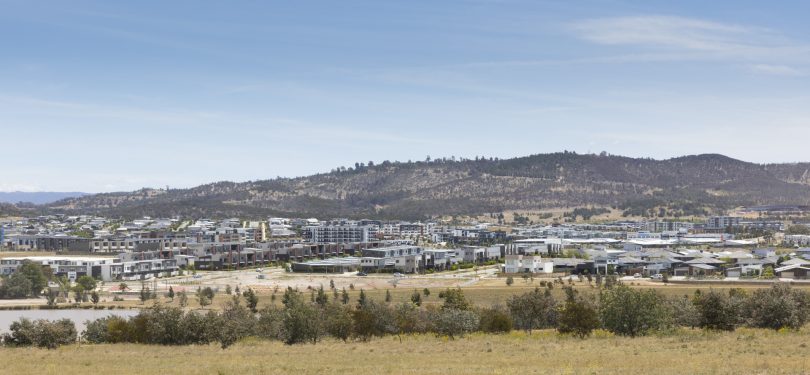
The new suburb of Coombs taking shape in the Molonglo Valley. Leaving room for tree plantings and green space is crucial to mitigating the heat-island effect. Photos: File.
Canberra architects have welcomed a new government guide to climate-wise development in the ACT but say it needs to be backed up by the planning system.
Institute of Architects ACT Chapter President Shannon Battison says anything that will encourage more greenery to curb heat island effects in a warming climate is a step in the right direction.
”We need as a city to value those green spaces and the green plantings, and so if it comes across as a guide that we can use to help show what the benefits are of having proper plantings around buildings then that will help,” she said.
”Backing that up though, as a city we need to have our planning system, saying no to designs that don’t allow space around them for planting.”
The new online guide for property professionals, builders and homeowners will help them plan and develop urban landscapes to cope with Canberra’s changing climate, and meet the ACT Government’s Living Infrastructure Plan targets of 30 per cent tree canopy cover and 30 per cent permeable surfaces as part of its climate strategy.
The government has contracted infrastructure firm Aecom to develop the user-friendly guide, which the contract specifications say will provide a step-by-step approach to identify landscape design solutions and develop block-scale climate-wise landscape plans, both at the pre-development stage and for retrofitting properties.
The government hopes the adoption of this advice will reduce urban heat island effects and increase shade, retain water in the landscape and use rainfall better, improve and increase green spaces in the city, and maintain biodiversity.
The guide will include sustainable garden design tips, climate-appropriate plants, information on site conditions, sustainable water use and rainwater capture, and appropriate surface options for gardens, pathways, driveways and public areas.
It will also canvass alternative landscaping options such as green walls, green roofs and rain gardens where building standards allowed.
The guide will cover drought and bushfire resistant plantings, tree canopy type, and size based on the proposed location on the site, as well as encouraging a diverse mix of plantings for achieving multiple goals including climate-resilience, good design, energy cost savings, amenity and environmental outcomes.
But it won’t include specific advice on what species to plant as this is already available.
The government has also contracted University of Canberra researchers to investigate best-practice climate-wise planning policy and provisions and identify options for integrating this into the ACT planning system.

Shannon Battison: ”We need to find a way to increase the planting and decrease the building size.”
Ms Battison said good developers looked to improve their developments and add something to a suburb, and one of the strongest things that they can do is provide meaningful green space.
”If you think of people in Canberra who have gone through the COVID lockdown in apartments, say in high-rises in the city or Belconnen, if that building doesn’t have a meaningful outdoor space they have no option during that lockdown to go somewhere nice, get the sun on their face,” she said.
Ms Battison said many architects and landscape architects were already aware of these issues but often the people who needed to be convinced were homeowners themselves.
She said one of the biggest issues with climate change and the way that suburbs are being built was putting big houses on small blocks, which did not leave any meaningful space for planting.
”We need to find a way to increase the planting and decrease the building size,” she said.
Ms Battison, who does a lot of work in greenfield areas, is often urging clients not to surround their houses with heat-retaining concrete or artificial lawn but to use paving or other permeable surfaces.
”The heat-island effect in new suburbs is particularly big, and it really eliminates the ability to naturally cool our suburbs and our houses,” she said.
”So if we can get permeability and shading, our heat island effect is going to be significantly impacted, which would be a big win for our suburbs.”
The climate-wise landscape guide is due to be delivered by 28 August, while the UC research for the planning system is due by 30 September.













